



Variables That Influence Outcomes Of AI Programmes
Sandy Johnson from K-State Research and Extension looks at what factors can impact a cow's ability to respond with high fertility to synchronisation protocols.Producers that achieve excellent responses to artificial insemination (AI) programmes have learned to manage a number of details. Various management decisions interact to influence a cow’s ability to resume normal estrous cycles before the start of the breeding season and conceive early in the breeding period. The goal of this paper is to review some of the factors that impact the cow’s ability to respond with high fertility to synchronisation protocols.
A key determinant of reproductive efficiency in beef cattle is the interval from calving to the resumption of normal estrous cycles, also known as the postpartum interval to estrus. Factors such as cow age, genetics, nutrition, calving difficulty, bull exposure, suckling stimulus, and management can all impact the postpartum interval. For review see Short et al., 1990 and Yavas and Walton, 2000.
Nutrition is often the biggest limiting factor in delayed rebreeding in commercial cow herds. Controlling winter feed costs are critical to lowering overall cow herd production costs, yet must be done in a way to achieve a profitable level of reproduction.

Body condition score is an accurate indicator of a cow’s body energy or nutritional status. In general, postpartum reproduction is impacted more by energy deficiencies before calving than after calving.
The relationship of body condition score at calving and postpartum interval to estrus is not uniform across condition scores. Low post-calving nutrition has less impact on the postpartum interval to estrus in a cow that calves at a body condition score of six than one that calves as a four (Figure 1; Short et al, 1990).
Only a moderate improvement (reduction) in postpartum interval to estrus is expected when a cow that calves in a body condition score of three receives high nutrition compared to adequate nutrition post-calving.

Because first calf heifers have additional nutrient demands for growth, shortfalls in nutritional programmes are emphasised in their reproductive responses. First calf heifers that calved at a body condition score of five or greater that were fed to either maintain or gain weight for 10 weeks after calving had similar pregnancy rates (91 and 94 per cent, respectively; Figure 2; Bell et al., 1990).
Heifers with body condition scores less than five at calving and fed to gain weight were able to compensate in body weight but not reproductive response.
Pregnancy rate was 36 per cent in heifers that had a body condition score less than five at calving and were fed to maintain weight, whereas those that were fed to gain weight after calving did so, but pregnancy rate (66 per cent) was still below those of heifers with body condition greater than and including five at calving (> 90 per cent).

Lalman and co-workers also evaluated effects of body condition score changes in young cows after calving on the postpartum interval to estrus (Table 1). Thin cows that gained as much as two body scores after calving still could not achieve the postpartum interval to estrus as those that calved in a body condition score of five or greater.
Stevenson and co-workers, 2003, examined the effects of body condition, cow age, and days postpartum of lactating beef cows on the initiation of estrous cycles and their influence on the proportion of cows cycling before and in response to synchronization protocols, as well as their effect on resulting fertility.
Conception during the first week of the breeding season is limited by the proportion of cows that have resumed normal estrous cycles (cycling) before thebeginning of the breeding season. Only 54 per cent of 3,269 beef cows studied were cycling before the onset of the breeding season.
Cow age, days postpartum, and body condition score at breeding influenced the proportion of cows cycling before estrus synchronisation as assessed by concentrations of progesterone in blood.
Compared with mature cows (64 per cent), fewer first calf heifers were cycling (55 per cent), despite calving up to 23 days earlier.
In contrast, no difference in interval to first postpartum estrus was found between cows that were two, three or four years of age (Cushman et al., 2007) when body condition score at breeding averaged 6.1 for two year olds (1.4 units above Stevenson et al., 2003).
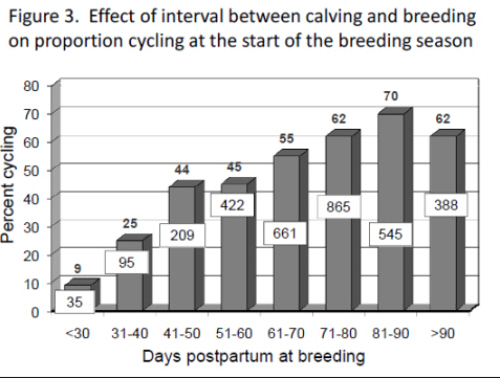
The percentage of cows cycling increased in a slightly curvilinear fashion for all cows regardless of age across days postpartum (Figure 3). Proportion cycling reached a peak at 81 to 90 days, and tended to decrease thereafter.
Average days postpartum at the onset of the breeding season were 86 for two year old cows and 68 for mature cows. The decreased percentage of cycling cows for those >90 d postpartum may be partly a reflection of reduced cyclicity in two year old cows, which constituted 85 per cent of the cows in this interval.Similar to days postpartum, the percentage of cows cycling increased linearly with increasing body condition (Figure 4) indicating that cows in lesser body condition were at greater risk for not cycling at the onset of the breeding season.
No interactions were detected between cow age and body condition or cow age and days postpartum.
Percentage of two year old and mature cows cycling by 21 day calving periods is illustrated in Figure 5.
For two year old cows, the cycling status at the onset of synchronisation treatments was not different among the first three 21-day intervals of the calving season, but was greater than the very late-calving cows (>63 dinto the calving season).
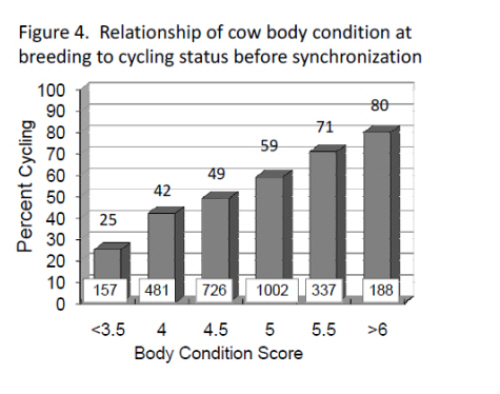
These results support the general recommendation to use a shorter breeding season for heifers to avoid problems with re-breeding late calving heifers. In contrast, cycling rates were greater for older cows that calved during the first 42 days of the calving season than for those that calved after day 42.
Early calving is critical because it allows more time for cows to resume estrous cycles before the breeding season.
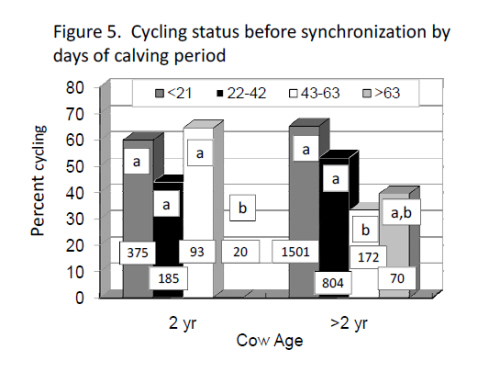
The ability to induce ovulation in non-cycling cows is key to the effectiveness of some of the more recently developed estrus and ovulationsynchronisation protocols.
Even in the best of situations there are likely to be a mix of cycling and non-cycling females to be bred. Ovulation was induced most successfully in noncycling cows after a CIDR or 14-d feeding of melengestrol acetate (MGA).
Induction of ovulation was limited in two year old cows until body condition scores were >5.0 (Figure 6). In older cows, induction of ovulation increased linearly with increasing body condition. In early postpartum cows (30 days postpartum), progesterone from the CIDR was more effective that MGA (Perry et al., 2004) for inducing ovulation and resulted in a higher proportion of luteal phases of normal length.
More cycling and non-cycling cows showed estrus after synchronization protocols that included a progestin compared to protocols that used only GnRH and prostaglandin or two injections of prostaglandin (Stevenson et al., 2003).
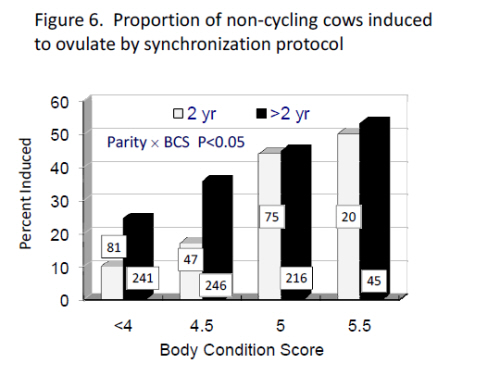
Synchronisation protocols that include a CIDR or other progestin can be used in noncycling cows to achieve pregnancy rates to fixed timed AI similar to cycling cows, provided the noncycling cows are not too deep in anestrus.
Several studies have found pregnancy rates to fixedtime AI in non-cycling cows equal to or even greater than those in cycling cows (Dobbins et al., 2009; Wilson et al., 2010).
The progestin in the protocol mimics the short rise in progesterone that often precedes the first normal length estrous cycle of either cows or heifers transitioning out of a period of anestrus.
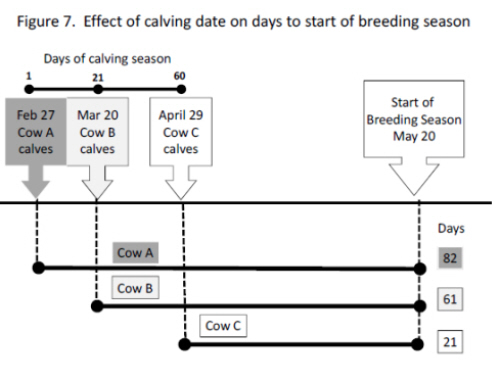
Cows that calve early have more time to resume normal estrous cycles before the breeding season starts and are more likely to conceive early in the breeding season. The cow that calves on the first day of the calving season has 82 days until the start of the breeding season (Figure 7).
A cow that calves on day 21 of the calving season has 61 days from calving until the start of the next breeding season, whereas the cow that calves on the last day of a 60 day calving period only has 21 days until the start of the breeding season.
If this cow cycles for the first time at 50 days postpartum, she would have 30 days to conceive in a 60 day season. Analysis of postpartum interval to estrus in Cycle VII at the Meat Animal Research Center found a range of 56 to 68 days depending on breed when body condition score was six or greater at the start of the breeding season (Cushman et al., 2007).
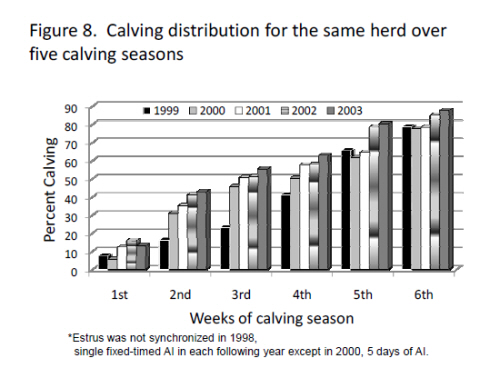
Depending on the initial calving distribution, using a synchronisation protocol every year can gradually increase the proportion of cows that calve in the first 30 days of the calving season and subsequently increase the pregnancy rates to AI in a parallel fashion. Data shown in Figure eight represent the proportion of the mature cow herd at the Agriculture Research Center in Hays that calved each week over five years beginning in 1999.
Only natural service was used during breeding in 1998 so that the calving distribution in 1999 represents no estrus synchronisation. In each of the following years, various single fixed-time AI protocols were used, with the exception of the 2000 breeding season where there was a five day period of AI after observed estrus.
The breeding season was 70 days long in 1999 and 2000 and final pregnancy rates were over 95%. The breeding season was shortened to 46 to 51 days in subsequent years with final pregnancy rates from 94 to 95 per cent.
When all cows are inseminated on day one of the breeding season in a fixed-timed AI protocol, cows should have three chances to conceive within a 45 to 50 day breeding season. The following year the last cow to calve will have 10 more days to resume normal estrous cycles than in a 60 day season.
Shortening the breeding period on two year old cows and maintaining desired pregnancy rate may be harder than doing so for mature cows. Identifying late calving cows with timely pregnancy diagnosis, and culling as appropriate, is one approach to shorten the calving period.
Managing cows to achieve appropriate weight (first calf heifers) and body condition by calving is a key step in cost effective reproduction. Forage testing and balancing rations in advance of the third trimester of pregnancy on an annual basis greatly reduces the risk of missing cow condition targets.
Cows that are less than 45 days postpartum on the first day of the breeding season will not respond as well to estrus synchronisation as those that calved earlier. Working toward a 60 day or shorter breeding season automatically provides an opportunity for more cows to cycle early in the breeding season as compared to longer breeding seasons.


